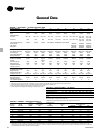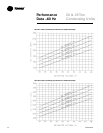
7SS-PRC005-EN
Selection
Procedure
RAUC/AIR HANDLER
Selection Procedure
Net capacity curves for the RAUC
condensing units are given on pages 14
through 23. These graphs can be used to
cross plot an evaporator (EVP)
performance curve. The resultant point
of intersection will be the system design
balance point. The design operating
suction temperature and capacity can
then be read directly from the graph.
(Note: It is usually necessary to account
for suction and liquid line losses in the
performance accordingly. The actual
losses are determined by the
interconnecting piping.)
To plot the evaporator performance
curve it is only necessary to obtain gross
evaporator capacities for the given
entering air conditions and cfm at two
different saturated suction temperatures.
The Trane Refrigeration Coil Computer
Selection Program can be used to
conveniently provide the necessary
evaporator capacity values at the
selected suction temperatures.
RAUC/EVP Selection
Procedure
Preselected RAUC/EVP capacities are
provided on pages 12 and 13. To select
for other RAUC/EVP combinations or
conditions, four quantities must be
known. They are:
a.
Entering (EWT) or leaving (LWT) water
temperature.
b.
Net cooling load (T).
c.
Water temperature drop (dt).
d.
Waterflow rate in gallons per minute
(gpm). Knowing any two of the last three
variables (T, dt, and gpm) will determine
the third since
T = (Gpm x dt)/24.
Standard Selection Procedure
1.
Determine: EWT, T, dt, gpm.
2.
Select an evaporator (EBP) and split
condensing unit (RAUC) to mix-match.
3.
Enter Charts PD-18, PD-20, and PD-21 to
find ITD/dt.
4.
From Step 3 calculate the saturated
suction temperature (SST) of the chiller
at the given load using the formula
SST = EWT - [(ITD/dt) x dt].
5.
Enter the appropriate RAUC capacity
chart on pages 14-23 with the result on
SST and given load, T. If this point is
below or on the proper condensing unit
performance curve at the same suction
temperature, the RAUC/EVP
combination will meet the desired load.
If above, try a larger chiller and/or
condensing unit. Repeat Steps 2 through
5 until the most economical mix-match
has been achieved.
Example
Given:
Ambient Air = 95°F
Supply Water Temperature = 45°F
Waterflow = 230 Gpm
Water Temperature Drop = 10°F
Step 1:
EWT = LWT + dt = 45°F + 10°F =
55°F
Gpm = 230 gpm (given)
dt = 10°F (given)
Step 2:
Choose a nominal RAUC and EVP:
RAUC-D10 and 100-ton EVP
Step 3:
Gpm/nominal tonnage = 230/100 = 2.30
ITD/dt is read from Chart PD-21 as 1.70,
assuming .0005 fouling factor.
Step 4:
SST =
EWT - [(ITD/dt) x dt] =
[55 - (1.70 x 10)] = 38.0°F = SST
Enter Chart PD-14 at 38.0°F SST and 95
ambient air. The condensing unit will
produce 1182 MBh at 38.0°F SST,
therefore the 100-ton EVP/RAUC-D10 is
the proper selection.
Alternative Selection Procedure
Given: The same information as in the
standard selection procedure plus a
predetermined condensing unit.
Enter the specified RAUC condensing
unit performance curve with the
appropriate cooling load T, to determine
the minimum required suction
temperature.
Enter Chart PD-14 with ITD/dt (EWT-
saturated suction temperature/dt) to
determine a gpm/nominal tonnage.
Since the gpm is known, the smallest
nominal size EVP can therefore be
calculated.
Example:
Given:
Ambient Air = 95°F
Condensing Unit - RAUC-C80
Supply Water Temperature - 45°F
dt = 10°F
T = 80.0 Tons
Step 1:
EWT = LWT + dt = 45°F + 10°F =
55°F
dt = 10°F
T = 80.0 Tons (960 MBh)
Gpm = 152
Step 2:
Enter Chart PD-13 at 95°F and 80.0 tons
to read the saturated suction
temperature (SST) as 39.7.
Step 3:
Enter Chart PD-21 at an ITD/dt = (EWT -
SST)/dt = (55 - 39.7)/10 = 1.53
Then read the maximum gpm/nominal
tons as 1.87 (assume .0005 fouling
factor). Therefore since 1.87 = Gpm/
Nominal Ton = 152/1.87 = 81.4 Tons. An
80-ton EVP is the optimum selection.


















